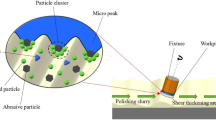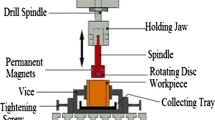Abstract
With the development of mould manufacturing industry, the high precision polishing technologies of Ni–P-coated SKD11 steel are in high demand. In this work, the factors influencing the magnetic material polishing process were determined by investigating the force distribution of carbonyl iron (CIPs) and abrasive particles (APs) in the working surface of magnetorheological fluid (MRF). The influence of certain factors, such as the diameters of the CIPs and the APs and the current and working distance (K), on the polishing surface quality, was assessed by fuzzy grey and Taguchi analysis. Results showed that the values of the fuzzy grey relationships with the surface quality of the factors were 0.4914, 0.7797, 0.6686 and 0.7461. Result showed that the fuzzy grey relationship point of factors known as diameters of the AGs had the most remarkable influence on the polishing effect, and the effect of CIP diameter was insignificant. The MRF contained commercially available CIPs that had been successfully applied for polishing the surface of magnetic materials with extremely high accuracy (surface roughness Ra = 0.561 nm) without leaving scratches on the surface after polishing.














Similar content being viewed by others
Data availability
This paper is not based on original data.
References
Lan X, Li C, Yang L, Xue C (2018) Deformation analysis and improvement method of the Ni-P mold core in the injection molding process. Int J Adv Manuf Technol 99(9–12):2659–2668. https://doi.org/10.1007/s00170-018-2584-7
Liu Y, Zhao W, Zhou T, Liu X, Wang X (2017) Surface defect elimination in microgrooving of electroless nickel phosphide plating layer by brittleness enhancement. Int J Adv Manuf Technol 94(1–4):1327–1333. https://doi.org/10.1007/s00170-017-0940-7
Lin Z-C, Lai W-L, Lin HY, Liu CR (1997) Residual stresses with different tool flank wear lengths in the ultra-precision machining of Ni-P alloys. J Mater Process Technol 65(1):116–126. https://doi.org/10.1016/0924-0136(95)02251-1
Dai C, Yin Z, Ding W, Zhu Y (2019) Grinding force and energy modeling of textured monolayer CBN wheels considering undeformed chip thickness nonuniformity. Int J Mech Sci 157–158:221–230. https://doi.org/10.1016/j.ijmecsci.2019.04.046
Zhao B, Ding W, Chen Z, Yang C (2019) Pore structure design and grinding performance of porous metal-bonded CBN abrasive wheels fabricated by vacuum sintering. J Manuf Process 44:125–132. https://doi.org/10.1016/j.jmapro.2019.06.001
Wang J, Ding W, Zhu Y, Fu Y (2019) Micro-fracture variation and grinding performance of PCBN superabrasive grains in high-speed grinding. Int J Mech Sci 160:15–25. https://doi.org/10.1016/j.ijmecsci.2019.06.021
Tian F, Li Z, Lv C, Liu G (2016) Polishing pressure investigations of robot automatic polishing on curved surfaces. Int J Adv Manuf Technol 87(1–4):639–646. https://doi.org/10.1007/s00170-016-8527-2
Han G, Zhao J, Wang X (2016) Research on unbounded abrasive polishing process with assisted ultrasonic vibration of workpiece. Int J Adv Manuf Technol 88(1–4):209–218. https://doi.org/10.1007/s00170-016-8767-1
Liang H, Yan Q, Lu J, Luo B, Xiao X (2019) Material removal mechanisms in chemical-magnetorheological compound finishing. Int J Adv Manuf Technol 103(1–4):1337–1348. https://doi.org/10.1007/s00170-019-03594-5
Jain VK, Saren KK, Raghuram V, Sankar MR (2016) Force analysis of magnetic abrasive nano-finishing of magnetic and non-magnetic materials. Int J Adv Manuf Technol 100(5–8):1137–1147. https://doi.org/10.1007/s00170-016-8954-0
Guo H, Wu Y (2015) Ultrafine polishing of optical polymer with zirconia-coated carbonyl-iron-particle-based magnetic compound fluid slurry. Int J Adv Manuf Technol 85(1–4):253–261. https://doi.org/10.1007/s00170-015-7929-x
Barylski A, Piotrowski N (2018) Non-conventional approach in single-sided lapping process: kinematic analysis and parameters optimization. Int J Adv Manuf Technol 100(1–4):589–598. https://doi.org/10.1007/s00170-018-2644-z
Chebbi R (2016) Bingham fluid contact line dynamics. J Adhes Sci Technol 30(15):1681–1688. https://doi.org/10.1080/01694243.2016.1158344
Singh M, Srivastava A, Bhunia D (2017) Evaluation of marble slurry incorporated concrete using nondestructive methods. Mater Today Proc 4(9):9842–9845. https://doi.org/10.1016/j.matpr.2017.06.278
Furuya T, Wu Y, Nomura M, Shimada K, Yamamoto K (2008) Fundamental performance of magnetic compound fluid polishing liquid in contact-free polishing of metal surface. J Mater Process Technol 201(1):536–541. https://doi.org/10.1016/j.jmatprotec.2007.11.299
Guan F, Hu H, Li S, Liu Z, Peng X, Shi F (2018) A novel Lap-MRF method for large aperture mirrors. Int J Adv Manuf Technol 95(9–12):4645–4657. https://doi.org/10.1007/s00170-017-1498-0
Wang Y, Yin S, Hu T (2018) Ultra-precision finishing of optical mold by magnetorheological polishing using a cylindrical permanent magnet. Int J Adv Manuf Technol 97(9-12):3583–3594. https://doi.org/10.1007/s00170-018-2199-z
Wu J, Zou Y, Sugiyama H (2015) Study on ultra-precision magnetic abrasive finishing process using low frequency alternating magnetic field. J Magn Magn Mater 386:50–59. https://doi.org/10.1016/j.jmmm.2015.03.041
Liang H, Lu J, Pan J, Yan Q (2017) Material removal process of single-crystal SiC in chemical-magnetorheological compound finishing. Int J Adv Manuf Technol 94(5–8):2939–2948. https://doi.org/10.1007/s00170-017-1098-z
Wu J, Yin S, Xing B, Zou Y (2019) Effect of magnetic pole on finishing characteristics in low-frequency alternating magnetic field for micro-groove surface. Int J Adv Manuf Technol 104(9–12):4745–4755. https://doi.org/10.1007/s00170-019-04362-1
Jiao L, Wu Y, Wang X, Guo H, Liang Z (2013) Fundamental performance of Magnetic Compound Fluid (MCF) wheel in ultra-fine surface finishing of optical glass. Int J Mach Tools Manuf 75:109–118. https://doi.org/10.1016/j.ijmachtools.2013.09.003
Wang Y, Wu Y, Nomura M (2016) Feasibility study on surface finishing of miniature V-grooves with magnetic compound fluid slurry. Precis Eng 45:67–78. https://doi.org/10.1016/j.precisioneng.2016.01.010
Barman A, Das M (2018) Nano-finishing of bio-titanium alloy to generate different surface morphologies by changing magnetorheological polishing fluid compositions. Precis Eng 51:145–152. https://doi.org/10.1016/j.precisioneng.2017.08.003
Dabholkar A, Sundaram MM (2012) Study of micro-abrasive tool-making by pulse plating using Taguchi method. Mater Manuf Process 27(11):1233–1238. https://doi.org/10.1080/10426914.2012.663143
Yin S, Nguyen D, Chen F, Tang Q, Duc LA (2018) Application of compressed air in the online monitoring of surface roughness and grinding wheel wear when grinding Ti-6Al-4V titanium alloy. Int J Adv Manuf Technol 101(5–8):1315–1331. https://doi.org/10.1007/s00170-018-2909-6
Kadier A, Abdeshahian P, Simayi Y, Ismail M, Hamid AA, Kalil MS (2015) Grey relational analysis for comparative assessment of different cathode materials in microbial electrolysis cells. Energy 90:1556–1562. https://doi.org/10.1016/j.energy.2015.06.108
Kasman Ş (2013) Multi-response optimization using the Taguchi-based grey relational analysis: a case study for dissimilar friction stir butt welding of AA6082-T6/AA5754-H111. Int J Adv Manuf Technol 68(1-4):795–804. https://doi.org/10.1007/s00170-012-4720-0
Singh S (2012) Optimization of machining characteristics in electric discharge machining of 6061Al/Al2O3p/20P composites by grey relational analysis. Int J Adv Manuf Technol 63(9–12):1191–1202. https://doi.org/10.1007/s00170-012-3984-8
Li G-D, Yamaguchi D, Nagai M (2007) A grey-based rough decision-making approach to supplier selection. Int J Adv Manuf Technol 36(9–10):1032–1040. https://doi.org/10.1007/s00170-006-0910-y
Abhang LB, Hameedullah M (2012) Determination of optimum parameters for multi-performance characteristics in turning by using grey relational analysis. Int J Adv Manuf Technol 63(1–4):13–24. https://doi.org/10.1007/s00170-011-3857-6
Younas M, Jaffery SHI, Khan M, Khan MA, Ahmad R, Mubashar A, Ali L (2019) Multi-objective optimization for sustainable turning Ti6Al4V alloy using grey relational analysis (GRA) based on analytic hierarchy process (AHP). Int J Adv Manuf Technol 105(1):1175–1188. https://doi.org/10.1007/s00170-019-04299-5
Funding
This work was financially supported by the National Key R&D Program of China (Grant No. 2017YFE0116900) and The Science and Technology Planning Project of Hunan Province (Grant No. 2019JJ50089).
Author information
Authors and Affiliations
Contributions
The authors confirm contribution to the paper as follows: Study conception and design: Duytrinh Nguyen and Wu Jinzhong. Data collection: Nguyen Minh Quang. Analysis and interpretation of results: Le Anh Duc, Phung Xuan Son and Nguyen Minh Quang. Draft manuscript preparation: Wu Jinzhong and Duytrinh Nguyen. All authors reviewed the results and approved the final version of the manuscript.
Corresponding author
Ethics declarations
Conflict of interest
The authors declare that they have no conflict of interest.
Ethical approval
This paper does not contain any studies with human participants or animals performed by any of the authors.
Consent to participate
Consent to participate was obtained from all individual participants included in the study.
Consent to publish
Consent to publish was obtained from all individual participants included in the study.
Additional information
Publisher’s note
Springer Nature remains neutral with regard to jurisdictional claims in published maps and institutional affiliations.
Rights and permissions
About this article
Cite this article
Nguyen, D., Wu, J., Quang, N.M. et al. Applying fuzzy grey relationship analysis and Taguchi method in polishing surfaces of magnetic materials by using magnetorheological fluid. Int J Adv Manuf Technol 112, 1675–1689 (2021). https://doi.org/10.1007/s00170-020-06567-1
Received:
Accepted:
Published:
Issue Date:
DOI: https://doi.org/10.1007/s00170-020-06567-1




